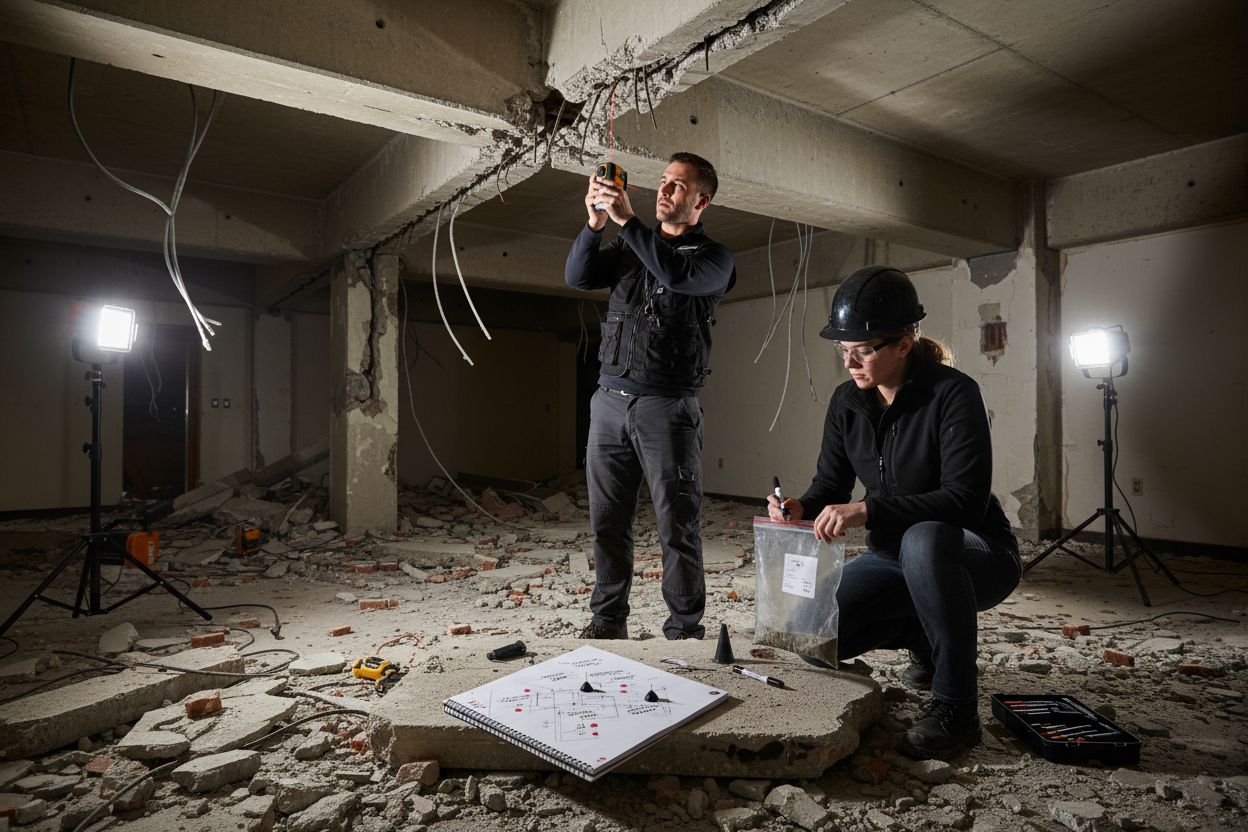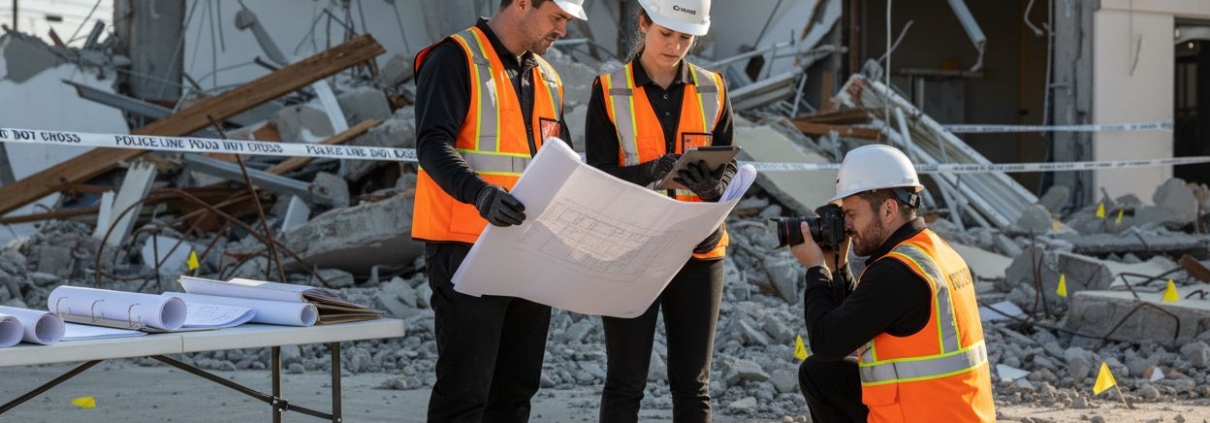Forensic Engineering Process: Step-by-Step Investigation Guide
Every year, faulty structures and engineering failures cause billions in property damage and spark complicated investigations. Understanding what went wrong is crucial for safety, accountability, and future prevention. Whether you are a seasoned engineer or a project manager facing tough questions, mastering the process of forensic engineering gives you the skills to uncover hidden causes and build strong, fact-based reports.
Quick Summary
| Key Point | Explanation |
|---|---|
| 1. Collect Comprehensive Project Information | Gather blueprints, permits, and inspection records to frame your investigation effectively. |
| 2. Document the Incident Thoroughly | Create a detailed account of the failure site using photos, sketches, and witness statements. |
| 3. Conduct a Systematic Site Inspection | Perform careful visual surveys, measurements, and collect physical samples to capture critical evidence. |
| 4. Analyze Structural and Environmental Factors | Use multiple analytical methods for a comprehensive understanding of the failure’s root causes. |
| 5. Compile a Detailed Forensic Engineering Report | Structure your findings clearly, providing conclusions and recommendations to guide future projects. |
Table of Contents
- Step 1: Gather Relevant Project And Incident Information
- Step 2: Inspect The Site And Document Physical Evidence
- Step 3: Analyze Structural And Environmental Factors
- Step 4: Determine Root Causes Through Technical Assessment
- Step 5: Compile Detailed Forensic Engineering Report
Step 1: Gather Relevant Project and Incident Information
When diving into forensic engineering, your first critical task is collecting comprehensive project and incident information. This foundational step sets the stage for a thorough and accurate investigation. Think of it like piecing together a complex puzzle where every document and detail matters.
Start by assembling all available project documentation. This means tracking down original architectural blueprints, structural designs, construction permits, maintenance records, and any previous inspection reports. According to ASCE’s Guidelines for Failure Investigation, the initial data collection phase is crucial for tailoring your investigation to the specific failure scenario.
Next, document the incident itself with meticulous precision. Gather written statements from witnesses, take comprehensive photographs of the damage or failure site, and create detailed sketches showing the exact location and nature of the problem. Wikipedia’s entry on forensic engineering emphasizes the importance of establishing safety and conducting an initial incident appraisal before deeper analysis.
Pro Tip: Create a dedicated digital folder for all collected materials. Organize documents chronologically and cross reference them to ensure nothing gets missed during your investigation.
Remember that information gathering is not just about collecting papers. Interview key personnel who were involved with the project or present during the incident. Their insights can reveal hidden details that documents might not capture. Ask specific questions about timelines, observed changes, and any unusual events leading up to the failure.
As you compile your information, maintain a systematic approach. Create an indexed document log, noting the source and date of each piece of evidence. This methodical process will prove invaluable when you transition to the analysis phase of your forensic engineering investigation.
Here’s a summary of key tasks and documentation for Step 1:
| Task | Examples | Purpose |
|---|---|---|
| Collect project documents | Blueprints Permits Inspections |
Establish design intent Document history |
| Gather incident records | Witness statements Photos Sketches |
Record event details Preserve evidence |
| Conduct personnel interviews | Key staff On-site workers |
Reveal additional insights |
| Organize & log information | Digital folders Document index |
Maintain systematic records |
Step 2: Inspect the Site and Document Physical Evidence
In forensic engineering, your site inspection is where theory meets reality. This critical step transforms collected information into tangible evidence that tells the complete story of what happened. Your goal is to document every nuance and detail of the failure location with scientific precision and investigative thoroughness.
According to Wikipedia’s forensic engineering resources, the site inspection involves multiple strategic actions including collecting evidence, taking precise measurements, creating detailed models, and potentially obtaining exemplar components for further analysis. Begin by establishing a comprehensive documentation strategy before you even set foot on the site.
Start with a methodical visual survey. Wear appropriate personal protective equipment and move systematically through the area. Photograph everything from multiple angles using high resolution cameras. Capture wide angle shots showing overall context and then zoom in for detailed closeup images of specific damage points or potential failure indicators. Measurements matter incredibly here document exact distances, dimensions, and spatial relationships.
Pro Tip: Create a site sketch or diagram while you are physically present. Digital measurements can fail but a hand drawn diagram with notes provides an irreplaceable record.
As ASCE’s course on building failure investigation emphasizes, pay special attention to structural systems and their condition. Look for signs of stress, material degradation, improper installation, or environmental impact. Note any repairs, modifications, or alterations that might have occurred since the original construction.
Collect physical samples carefully and systematically. This might include material fragments, concrete cores, soil samples, or mechanical components. Label each sample with location, date, and context. Proper chain of custody is crucial for maintaining the scientific integrity of your evidence.

As you complete your site inspection, prepare a comprehensive report detailing your observations. This document will serve as a critical foundation for the next phase of your forensic investigation where you will begin analyzing the collected evidence.
Step 3: Analyze Structural and Environmental Factors
In forensic engineering, the analysis of structural and environmental factors is where scientific detective work truly begins. You will transform the physical evidence gathered from your site inspection into meaningful insights that reveal the root causes of structural failures. Your mission is to understand the complex interactions between materials, environmental conditions, and structural performance.
According to ASCE’s webinar on structural forensic investigations, this phase involves multiple sophisticated assessment methods. Start by evaluating the load carrying capacity of the structure. This means understanding how different components interact under stress and identifying potential weak points that might have contributed to the failure.
Conduct detailed material assessments. For concrete and steel structures, this involves petrographic analysis and corrosion detection techniques. Look for signs of material degradation such as concrete cracking, steel corrosion, or unexpected material fatigue. Civil engineering research on metallurgical failure analysis highlights the importance of examining microscopic changes that might indicate long term structural weakness.
Pro Tip: Use multiple analytical tools. Microscopic examination, chemical analysis, and computational modeling can provide complementary insights that a single method might miss.
Carefully document environmental factors that could have influenced the structural failure. This includes temperature variations, moisture exposure, chemical interactions, soil conditions, and potential external stressors. Each environmental element can play a significant role in material performance and structural integrity.
Utilize advanced diagnostic techniques like non destructive testing methods. Ultrasonic scanning, X ray analysis, and thermal imaging can reveal internal structural conditions without causing additional damage. These techniques allow you to see beyond surface level observations and understand the deeper structural narrative.
As you compile your analysis, prepare a comprehensive report that connects physical evidence with scientific interpretation. Your next step will be developing a clear explanation of how specific structural and environmental factors contributed to the observed failure.
Step 4: Determine Root Causes Through Technical Assessment
This is the moment where your forensic engineering investigation transforms raw data into definitive insights. Your technical assessment will systematically unravel the complex puzzle of structural failure by connecting evidence, scientific analysis, and engineering principles. Think of yourself as a scientific detective piecing together the ultimate explanation.
According to ASCE’s Guidelines for Failure Investigation, data analysis and interpretation represent the core steps in determining failure origins. Begin by organizing all collected evidence chronologically and creating a comprehensive timeline of events leading to the structural failure.
Utilize laboratory testing as your primary technical assessment tool. Forensic metallurgical research recommends employing fractography and compositional analyses to distinguish between material flaws, installation issues, service degradation, and environmental factors. Examine material samples under microscopic conditions to reveal subtle structural weaknesses invisible to the naked eye.
Pro Tip: Always cross reference your laboratory findings with site observations. Consistent evidence across multiple assessment methods increases the reliability of your root cause determination.
Apply systematic elimination techniques. Rule out potential causes one by one through rigorous scientific testing. Consider mechanical stress, material fatigue, environmental degradation, design flaws, and installation errors as potential contributors. Your goal is to identify not just what failed but precisely why it failed.
Compare your findings against industry standards and engineering specifications. Look for deviations that might explain the structural failure. Numerical data points like stress tolerances, material composition, and load bearing capacities become critical pieces of evidence in your technical reconstruction.
As you complete your technical assessment, prepare a detailed report that clearly articulates the root causes. Your next phase will involve developing recommendations for preventing similar failures in future projects.
Step 5: Compile Detailed Forensic Engineering Report
The forensic engineering report is your ultimate narrative weapon transforming complex technical findings into a clear compelling story of structural failure. This document will communicate your investigative journey with scientific precision and professional clarity. Your goal is to create a report that speaks authoritatively to engineers, lawyers, insurance professionals, and technical experts.
ASCE’s guidelines emphasize the critical importance of presenting professional opinions and conclusions following comprehensive analysis. Begin by creating a structured report with distinct sections that walk readers through your investigative process step by step.
Start with an executive summary that concisely captures the entire investigation. This section should provide a high level overview of the incident, your key findings, and primary conclusions. According to forensic metallurgical research, this summary often serves as a critical document for legal resolution or remediation planning.
Pro Tip: Write your executive summary last. After completing the entire report, you will have a more comprehensive understanding of the narrative flow.
Organize your technical sections methodically. Include detailed documentation of your investigation methodology, presenting each piece of evidence with scientific objectivity. Clearly explain how you collected data, what testing procedures you used, and how you reached your conclusions. Include high resolution photographs, diagrams, and technical charts that support your findings.
Address potential alternative explanations and demonstrate why your root cause analysis is the most probable scenario. Professional credibility comes from showing that you considered multiple perspectives before reaching your final conclusions.
Conclude with clear actionable recommendations. Your report should not just diagnose the problem but provide a roadmap for prevention and potential remediation. Learn more about our comprehensive forensic engineering services to understand how we turn technical insights into practical solutions.
Ready for Expert Forensic Engineering Solutions?
You have just learned the step-by-step forensic engineering process and how essential it is to gather comprehensive evidence, conduct precise site inspections, and deliver clear, actionable reports. But when a structural failure disrupts your residential or commercial project, tackling these technical challenges alone can lead to missed details, costly delays, and uncertainty about the true cause of the problem. That is why it is critical to have experienced professionals who turn complex forensic investigations into clear solutions for your property.

Take the next step toward protecting your investment and securing peace of mind. At Florida Licensed Engineers, we offer complete forensic investigation and reporting tailored to your unique situation, supporting every phase from site inspections and engineering plans to comprehensive project documentation. Explore how our licensed experts pinpoint issues and provide guidance for remediation, prevention, and compliance. Visit our main service page to request an evaluation or learn more about how our expertise can resolve your engineering concerns today.
Frequently Asked Questions
What is the first step in the forensic engineering process?
The first step in the forensic engineering process is to gather all relevant project and incident information. Start by collecting documentation such as architectural blueprints, inspection reports, and witness statements to build a solid foundation for your investigation.
How do I conduct a site inspection for a forensic engineering investigation?
To conduct a site inspection, perform a visual survey and document every detail meticulously. Take high-resolution photographs and notes on measurements, and create sketches to accurately capture the site conditions.
What methods are used to analyze structural and environmental factors?
Analyzing structural and environmental factors typically involves evaluating load carrying capacity and conducting material assessments. Utilize techniques like non-destructive testing and environmental condition monitoring to gather detailed insights on potential issues.
How can I determine the root causes of a structural failure?
To determine root causes, use laboratory testing to analyze material samples systematically and rule out potential causes. Develop a timeline of events leading to the failure and cross-reference findings with site observations for a comprehensive understanding.
What should be included in a forensic engineering report?
A forensic engineering report should include an executive summary, detailed methodology, and your findings supported by evidence. Ensure to present your conclusions clearly and provide actionable recommendations for preventing future failures.
![]()
How can I organize the collected information during an investigation?
Organize collected information by creating a dedicated digital folder and using an indexed document log. This will help maintain systematic records and cross-reference data efficiently, ensuring nothing gets overlooked during the investigation.




